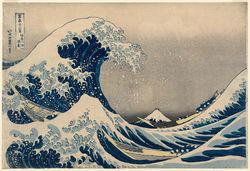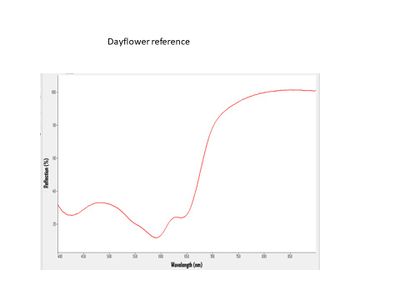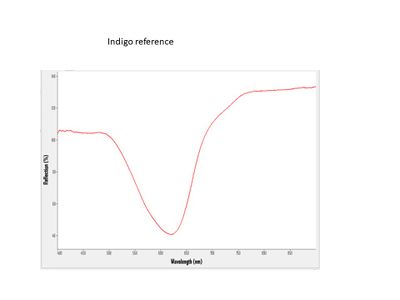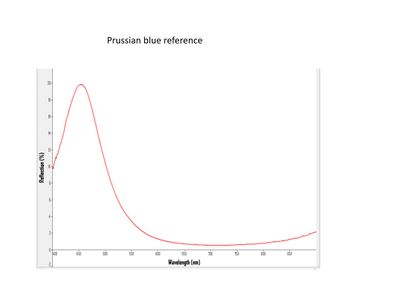Difference between revisions of "Category:Prussian Blue: Ukiyo-e colorant"
| (7 intermediate revisions by the same user not shown) | |||
| Line 1: | Line 1: | ||
| − | [[File:SC130566.jpg|right|250px|link= | + | [[File:SC130566.jpg|right|250px|link=Hokusai, Under the Wave off Kanagawa, also known as the Great Wave, from the series Thirty-six Views of Mount Fuji, 21.6765|Great Wave by Katsushika Hokusai]] |
<font size="3">'''[[Prussian blue]]'''</font> ベロ藍(''bero-ai''): The first modern synthetic pigment, Prussian blue was an accidental discovery made around 1704-6 by chemist Johann Jacob Diesbach and alchemist Johann Conrad Dippel. Composed of ferric ferrocyanide, this synthetically produced pigment yields a vivid blue. Due to its high cost as an import from the West during the 1800’s, it was used initially for paintings. By the end of the 1820’s, this pigment was produced in China, thus making it affordable for use as a colorant for woodblock printing. | <font size="3">'''[[Prussian blue]]'''</font> ベロ藍(''bero-ai''): The first modern synthetic pigment, Prussian blue was an accidental discovery made around 1704-6 by chemist Johann Jacob Diesbach and alchemist Johann Conrad Dippel. Composed of ferric ferrocyanide, this synthetically produced pigment yields a vivid blue. Due to its high cost as an import from the West during the 1800’s, it was used initially for paintings. By the end of the 1820’s, this pigment was produced in China, thus making it affordable for use as a colorant for woodblock printing. | ||
| Line 42: | Line 42: | ||
== Analysis == | == Analysis == | ||
| − | Fiber optic reflectance spectroscopy (FORS) can easily identify the three blues: [[:Category: | + | Fiber optic reflectance spectroscopy (FORS) can easily identify the three blues: [[:Category:Dayflower: Ukiyo-e colorant|dayflower]], [[:Category:Indigo: Ukiyo-e colorant|indigo]], and Prussian blue. |
<gallery mode=packed heights=200px style="text-align:left"> | <gallery mode=packed heights=200px style="text-align:left"> | ||
| + | Dayflower FORS.JPG|<center>FORS spectrum of Dayflower reference</center> | ||
Indigo FORS.JPG|<center>FORS spectrum of Indigo reference</center> | Indigo FORS.JPG|<center>FORS spectrum of Indigo reference</center> | ||
| − | + | Prussian blue FORS.jpg|<center>FORS spectrum of Prussian blue reference</center> | |
| − | |||
</gallery> | </gallery> | ||
==Other Images of Prussian blue == | ==Other Images of Prussian blue == | ||
<gallery> | <gallery> | ||
| + | Prussian blue lumps.jpg|Lumps of Prussian blue, <small>by Takeo City Library</small> | ||
| + | File:448 Prussian blue.jpg|Prussian blue | ||
File:Prussianblue C100x.jpg|Prussian blue | File:Prussianblue C100x.jpg|Prussian blue | ||
File:38_Prussian_blue_500X.jpg|Prussian blue | File:38_Prussian_blue_500X.jpg|Prussian blue | ||
| Line 56: | Line 58: | ||
==List of Prints == | ==List of Prints == | ||
| − | + | Below is a list of prints where Prussian blue was detected. | |
| − | |||
| − | |||
| − | |||
| − | |||
| − | |||
Revision as of 00:14, 27 July 2020
Prussian blue ベロ藍(bero-ai): The first modern synthetic pigment, Prussian blue was an accidental discovery made around 1704-6 by chemist Johann Jacob Diesbach and alchemist Johann Conrad Dippel. Composed of ferric ferrocyanide, this synthetically produced pigment yields a vivid blue. Due to its high cost as an import from the West during the 1800’s, it was used initially for paintings. By the end of the 1820’s, this pigment was produced in China, thus making it affordable for use as a colorant for woodblock printing.
Prussian blue's bright, intense “true blue” color, fine particle size, and high tinting strength soon made it an indispensable addition to the printmaker’s palette, largely supplanting dayflower and indigo. This enabled an even, sharp printing as well as a greater range of tones especially when printing graduated color. It is thought that the introduction of this colorant into the printmaker’s palette stimulated Hokusai and Hiroshige to design the iconic landscape prints that they are celebrated for. Prussian blue is both lightfast and stable to moisture.
For more information see: Prussian blue
Examples of Prussian blue in Ukiyo-e Prints

|

|

|

|

|
Analysis
Fiber optic reflectance spectroscopy (FORS) can easily identify the three blues: dayflower, indigo, and Prussian blue.
Other Images of Prussian blue
List of Prints
Below is a list of prints where Prussian blue was detected.
Pages in category "Prussian Blue: Ukiyo-e colorant"
The following 12 pages are in this category, out of 12 total.
E
H
- Hiroshige I, Enjoying the Cool of Evening on the Riverbed at Shijô, from the series Famous Views of Kyoto, 06.890
- Hiroshige I, Pine of Success and Oumayagashi, Asakusa River, from the series One Hundred Famous Views of Edo, 11.17029
- Hiroshige I, The Yodo River, from the series Famous Views of Kyoto, 11.2111
- Hiroshige I/Hiroshige II, Ueno Yamashita, from the series One Hundred Famous Views of Edo, 11.35842
- Hokkei, Ômori, from the series Souvenirs of Enoshima, a Set of Sixteen, 11.19845
K
- Kuniyoshi, (Actor Ichikawa Ebizô V as) Inuyama Dôsetsu, from the series The Lives of Eight Brave and Loyal Dog Heroes, 11.28841
- Kuniyoshi, Drying Board Suggesting Hiyodorigoe, from the series Women in Benkei-checked Fabrics, 11.36363
- Kuniyoshi, Hosokute: Horikoshi Dairyô, from the series Sixty-nine Stations of the Kisokaidô Road, 11.28766








